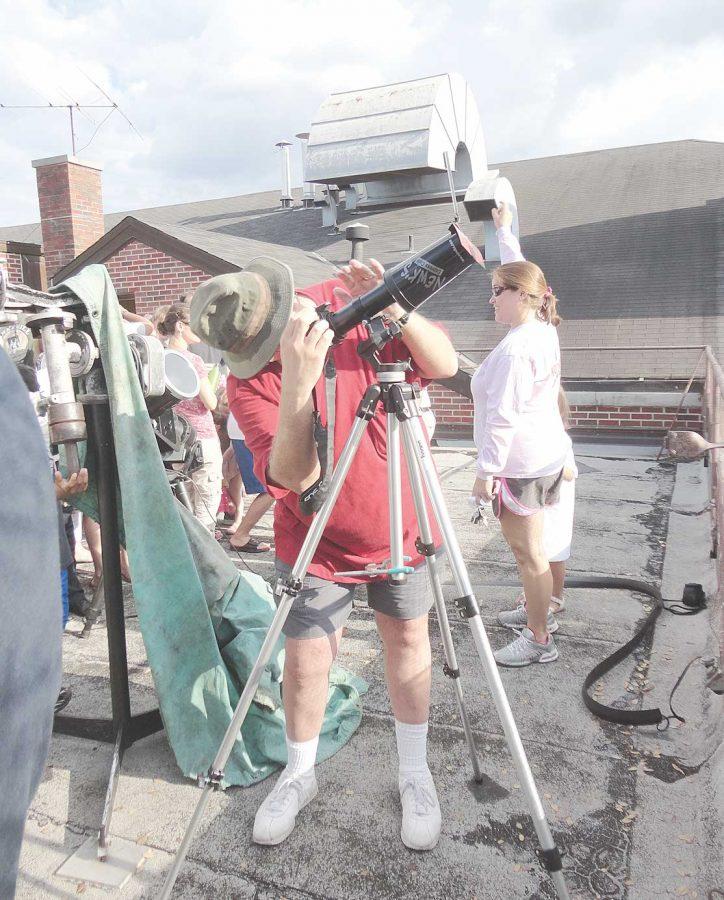Many students at The University of Alabama sat in Gallalee Hall for Astronomy 101 just to fulfill the general education requirement for science. William Keel, professor of astronomy and astrophysics, said the department sees more than 800 students come through every year.
The majority of students who sit through the class won’t pursue it any further, though, and many of them probably do not know what the members of the astronomy department are doing outside of teaching classes. The faculty’s small size makes the group tight-knit, and six of the seven members focused their research on extra-galactic astronomy.
“A lot of people talk about their research together because it is such a similar area,” Jeremy Bailin, an assistant professor of astronomy and astrophysics, said.
Bailin studies galaxy formation, and much of his work is based on creating simulations of galaxies to gather data. He works mostly with theory. Bailin is a more recent addition to the department, having only been there for two years, but he said he is still excited about growth in the department.
(See also “Astronomy, physics department to host public night March 15“)
“There certainly is a lot of student interest in astronomy,” Bailin said. “Astronomy is cool. I am a bit biased, but you know people are always interested in the stars and looking at the sky.”
Each semester, the number of students taking Astronomy 101 fluctuates between 400 and 500 students. Last semester, 495 students were enrolled. This semester there are 528.
The number of professors in the department continues to grow as the student population grows. This year, the astronomy department added a seventh member to the group, Preethi Nair, for the first time in the department’s history.
“We’ve been six since 1989,” said Keel, who has been at the University for 27 years.
Keel said it was becoming increasingly necessary for the department to add another faculty member due to the enrollment pressure.
For many of the professors, teaching an introductory class like Astronomy 101 to non-physics or astronomy majors can be challenging.
“It’s definitely a challenge, but it’s also a lot of fun,” Bailin said. “There are a lot of misconceptions about astronomy, and it’s hard to make people really understand. You can’t just tell someone this is how the phases of the moon work. You have to show them and demonstrate it to them.”
Caroline Lassiter, a senior majoring in education, took Astronomy 101 her sophomore year to fulfill a science requirement. Though she said she does not plan on pursuing a degree in astronomy, she is grateful for the knowledge she gained from the class.
(See also “Astronomy professor investigates space gas cloud“)
“I think it just taught me to appreciate the sky and the universe,” Lassiter said. “Because I am not an astronomy major, I won’t always be able to learn more about it. But even just from taking Astronomy 101, I have a better understanding of the universe and what I am seeing when I look up at the sky, and that is pretty cool.”
Ron Buta has been a professor of astronomy and physics at the University for more than 25 years, and said it is not always easy to keep young people interested in the introductory classes.
“Even though I’ve been teaching for [more than] 25 years, it’s still difficult sometimes,” Buta said.
Once a semester, he dresses up in an alien costume and has an “Alien Day” to make class a little more fun and exciting.
“It’s fun to contemplate,” Buta said. “I mean, in what other class on campus do you get to talk about aliens?”
Last month, Keel was was able to do a class session with a remotely operated telescope in Chile. The nebula the students saw on the screen was in a part of the sky that is never above the horizon in Tuscaloosa.
“In the last six or eight years, we have really revitalized the department,” Keel said. “We renovated the observatory that once housed an antique telescope. Students jumped a century into the future when we got the 16-inch telescope.”
Plus, with the ability to use remote telescopes now, students can view live images during the day when they normally would not be able to.
The astronomy department offers public events for the community as well, to give them the opportunity to experience what the department has to offer. On Tuesday, April 15, there will be a total lunar eclipse, and students and community members are encouraged to come to the Galilee Hall Observatory to watch. It will last from 1:00 a.m until 4:30 a.m. Though it will be a late night, Keel encourages people to check it out.
“It’s been three years since the last time there was a lunar eclipse you could see in our area,” Keel said.
For more information about the astronomy program and its events, visit astronomy.ua.edu.
(See also “Physics meet brings high school students to campus“)









